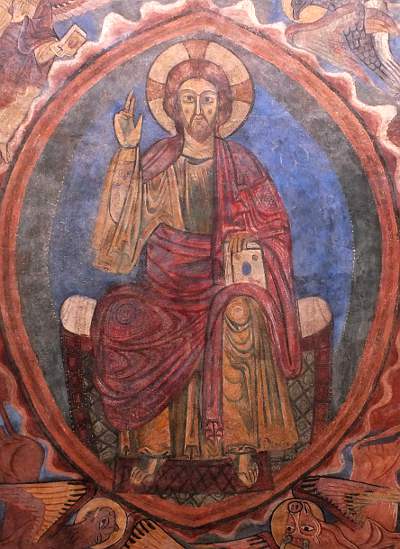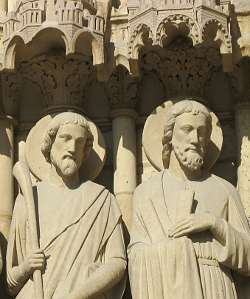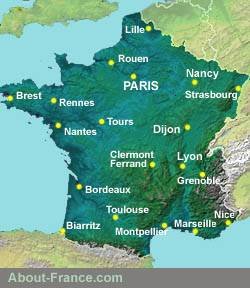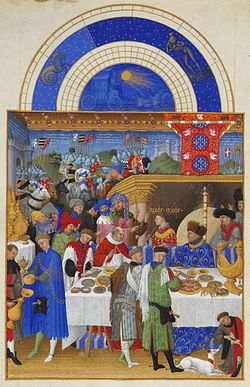
French art up to the Middle Ages
A short history of French Art - 1.
About-France.com
- the connoisseur's guide to France
Art in France from prehistory to the Middle Ages
This page looks at the early history of art in France - notably painting - from prehistoric times up to the Middle Ages.
 Cave
painting at Lascaux
Cave
painting at LascauxLittle remains of French painting from before the year 1000 AD; the great centres of painting in Europe before this time were in Italy, Byzantium and to a lesser degree Spain; but not in France. It was only with the emergence of medieval Europe from the tenth century onwards that France (that is the area of Europe that is now France) became a key player on the international stage.
 Detail
of the 11th century fresco in the baptistry at Poitiers - depicting
Christ.
Detail
of the 11th century fresco in the baptistry at Poitiers - depicting
Christ.
12th century Byzantine style fresco in the Basilica of St Julien, Brioude, Auvergne
France has relatively little in the way of painting from the early Gothic period; the finest examples of early French Gothic art - as opposed to architecture - are in the form of stained glass, as in the cathedrals at Chartres or Laon or Bourges, or sculpture, notably the many fine examples of gothic sculpture adorning French cathedrals. Like the Romanesque style, the Gothic style of architecture was one that developed in France, from where it quickly spread to much of Europe, and in particular to England which, at the time, being ruled by Normans then Angevins, was an integral part of the French cultural area.
Gothic architecture reached its finest expression in the great 12th and 13th century cathedrals of northern France and England: inFrance, the finest medieval Gothic cathedrals are in Paris, Amiens, Reims, Rouen, Strasbourg and Beauvais.
By the 14th century however, a different art of painting was developing rapidly in France, the art of the illustrated manuscript. Of particular importance were French "Books of hours", prayer books comprising prayers, psalms and biblical texts, many of which were lavishly illustrated. The most famous of these is the Très Riches Heures du Duc de Berry, which contains over a hundred page illustrations depicting, among otherthings, contemporary life.
 Gothic sculpture on the facade of
Notre Dame Cathedral, Paris
Gothic sculpture on the facade of
Notre Dame Cathedral, ParisThe About-France.com history of art in France :
- Art and architecture in Medieval France
- French art in the Renaissance
- French art from Baroque to Rococo - 1590 - 1790
- Neoclassicism and Romanticism
- Naturalism and realism - landscape and life in 19th century French art
- Impressionism
- Post- Impressionism - from Pointillism to Cubism
► Discover medieval France:
- France's greatest medieval cathedrals
- Great medieval castles in France
- The Cathars and Cathar castles
- The Palace of the Popes in Avignon
Copyright
© About-France.com except where otherwise stated.
About-France.com
Home
page - Site
search
- Regions
- Maps of France
- Contact
Photo top of page : : 14th century stained
glass in Laon cathedral
© About-France.com


Medieval stained glass in Chartres cathedral

Page from the Très Riches Heures du Duc de Berry
Photos:
All photos © About-France.com except
Chartres stained glass window by Mossot, GNU license.
Très Riches Heurs public domain.
Lascaux © UNESCO released under creative commons licence.
About-France.com is a fully independent website affiliated to certain online booking platforms, and may receive a small commission only on bookings made through affiliate sites . This has no effect at all on the price paid by the visitor.
Map from Openstreetmap.
Copyright texts © About-France.com
© About-France.com
France
is famed as one of the world's great centres of art and culture.
France's medieval heritage is magnificently displayed through the great historic monuments that have come down to this day - notably cathedrals, churches and castles. Medieval French painting is less well known.
France's medieval heritage is magnificently displayed through the great historic monuments that have come down to this day - notably cathedrals, churches and castles. Medieval French painting is less well known.


Medieval stained glass in Chartres cathedral

Page from the Très Riches Heures du Duc de Berry
Photos:
All photos © About-France.com except
Chartres stained glass window by Mossot, GNU license.
Très Riches Heurs public domain.
Lascaux © UNESCO released under creative commons licence.
About-France.com is a fully independent website affiliated to certain online booking platforms, and may receive a small commission only on bookings made through affiliate sites . This has no effect at all on the price paid by the visitor.
| ►► Site guide |
| About-France.com home |
| Full site index |
| About-France.com site search |
| ►► Principal chapters on About-France.com |
| The
regions of France Beyond
Paris, a guide to the French regions and their tourist attractions.
|
| Accommodation
in France |
| Guide
to Paris Make
the most of your trip to Paris; attractions,
Paris hotels,
transport, and lots more.
|
| Tourism
in France
The
main tourist attractions and places to visit in France - historic
monuments, art galleries, and more
|
| Planning
a trip to
France
Information
on things to do before starting your trip to France.
|
| Driving
in France
Tips
and useful information on driving in and through France - motorways,
tolls, where to stay....
|
| Maps
of France
Cities,
towns, departments, regions, climate, wine areas and other themes.
|
| The French way of
life
A
mine of information about life and living in France,
|
| A-Z
dictionary
of France Encyclopedic
dictionary of modern France
|
Click here for
low-cost car hire in France
low-cost car hire in France
Map from Openstreetmap.
Copyright texts © About-France.com
